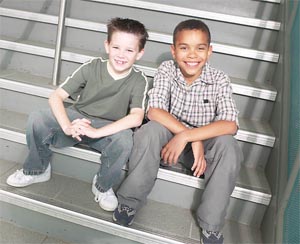|
 |
| Teachers.Net Gazette Vol.6 No.6 | June 2009 |
Subscribe for free home delivery |
|
Buddy Programs for Elementary Schools Buddy programs consist of upper-grade students paired with younger children for projects and other interaction. The experience provides benefits for both students involved, providing children with stimulating opportunities for learning, skill development and social support. | ||
| by Leah Davies, M.Ed. www.kellybear.com Continued from page 1 June 1, 2009 |
||
 If buddies are matched up by the teachers in advance, the first meeting can include a short interview, a game or an activity. The older students can read to their new friend and/or listen to the younger child read. The session can include a snack and be held in either classroom, outdoors or anywhere it is convenient. Activities that buddies can do together vary widely and are only limited by the imagination of the teachers, the age of the students, and the boundaries provided by the administration. They can read books, write stories, plan skits, do science experiments, play math games, cook, sing songs, go on scavenger hunts, complete art projects, or go on field trips. In some schools, young children dictate stories to the upper grade students who write everything down in a Buddy Journal. Projects can be presented to other students and/or displayed in the library, hallway, or classroom. Providing guidance in a computer lab is another way buddy programs function. Computer activities provide an opportunity for older students to show what they know. As a result, computer skills are fostered by both partners. Since the younger children look up to the older students, the older buddies try hard to be of assistance and their feelings of self-worth are enhanced. Teachers may allow time for the children to reflect on how the program is working. If a student is not relating well to his or her buddy, teachers need to offer guidance, support, and possibly make changes. The program can also include a mix of small group work as well as partner projects. For example, if the students decide to present a play at the end of the year, they could write it, assign parts, practice lines, paint scenery, make costumes, and perform it for faculty, students and/or parents. Students who are new to a school or are English language learners benefit from having a buddy assigned to them. For example, students entering a school for the first time, or moving to a new school district need help to make a successful transition. A buddy can be an older student or a classmate who assists them in finding their way around and answering their questions. A student who speaks the newcomer‘s language is a great asset to the learner. A peer-tutoring program is similar to a buddy program. However, it only includes children in need of academic assistance. An older student is paired with a child that he or she tutors once or twice a week, before or after school or during school hours. Some programs are coordinated by an elementary school counselor or by a school librarian. Teacher comments confirm that buddy programs have a positive influence on the students involved. The form they take is varied and flexible. A program may begin by a principal asking two interested teachers to establish a partnership. As Sue Gruber, a kindergarten teacher whose class buddies with a sixth grade class wrote, ”It is wonderful to see the bonds that form.... It really brings out the best in the kids.” Used by permission of the author, Leah Davies, and selected from the Kelly Bear website [www.kellybear.com], 12/04. | ||
|


 Leah Davies received her Master's Degree from the Department of Counseling and Counseling Psychology, Auburn University. She has been dedicated to the well-being of children for 44 years as a certified teacher, counselor, prevention specialist, parent, and grandparent. Her professional experience includes teaching, counseling, consulting, instructing at Auburn University, and directing educational and prevention services at a mental health agency.
Leah Davies received her Master's Degree from the Department of Counseling and Counseling Psychology, Auburn University. She has been dedicated to the well-being of children for 44 years as a certified teacher, counselor, prevention specialist, parent, and grandparent. Her professional experience includes teaching, counseling, consulting, instructing at Auburn University, and directing educational and prevention services at a mental health agency.